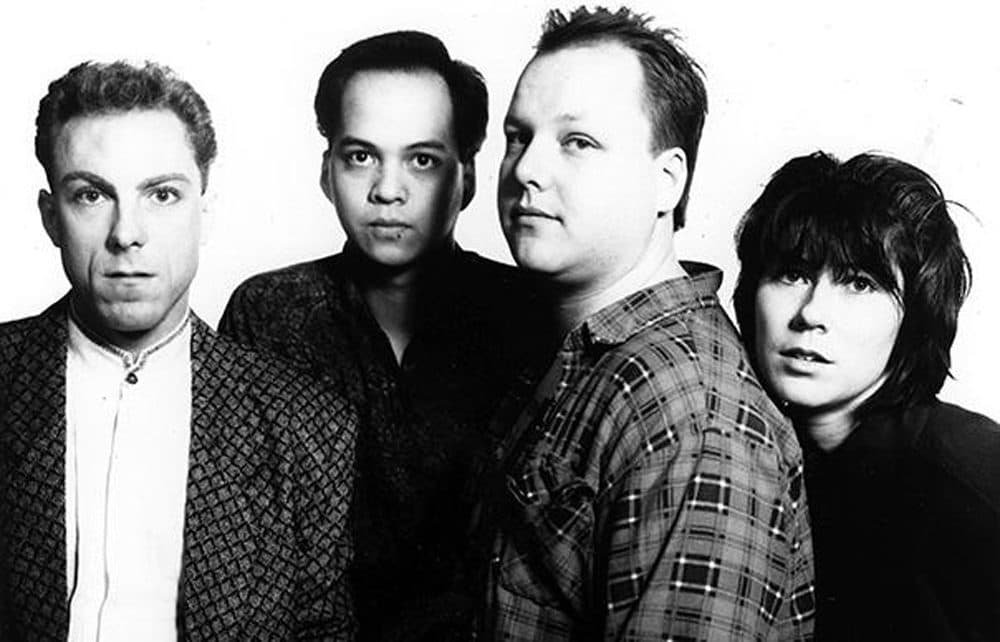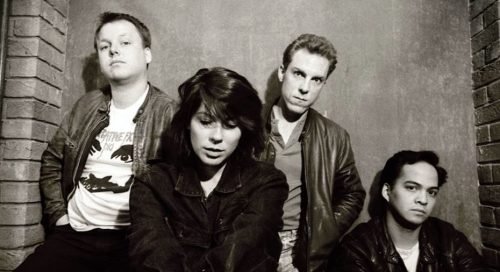In the late 1980s, the alternative rock scene experienced a seismic shift with the emergence of the Pixies, a band that would go on to become one of the most influential groups in the genre. Formed in Boston in 1986, the Pixies—comprising Black Francis (vocals, guitar), Joey Santiago (lead guitar), Kim Deal (bass, vocals), and David Lovering (drums)—brought a raw, unconventional approach to rock music that challenged the status quo. Their distinctive sound, characterized by surreal lyrics, abrasive guitars, and an eclectic mix of punk and surf rock influences, set them apart from their contemporaries.
A key component of the Pixies’ revolutionary style was their innovative use of the quiet-loud-quiet dynamic. This technique, where songs transition abruptly from subdued, mellow verses to explosive, high-energy choruses and back again, became their signature. It was a departure from the more linear, predictable structures of mainstream rock, creating a sense of tension and release that captivated listeners. This dynamic not only defined the Pixies’ sound but also laid the groundwork for the grunge movement of the early 1990s and influenced countless bands in the decades to follow.
The quiet-loud-quiet dynamic was more than just a musical gimmick; it was a powerful tool for expressing emotional extremes and capturing the unpredictability of human experience. By alternating between restraint and intensity, the Pixies crafted songs that were both accessible and deeply impactful, resonating with a broad audience and leaving an indelible mark on the evolution of alternative rock.
Origins of the Quiet-Loud-Quiet Dynamic

Early Influences and Precursors
Before the Pixies revolutionized alternative rock with their quiet-loud-quiet dynamic, the seeds of this technique were already present in the music of several pioneering artists. Bands like The Beatles and The Velvet Underground had experimented with varying intensities within songs, while punk rock bands like The Stooges and Ramones emphasized raw, high-energy performances. However, these early attempts lacked the stark, deliberate contrasts that the Pixies would perfect.
The Pixies were also influenced by the post-punk and new wave movements of the late 1970s and early 1980s, where bands like Talking Heads and Public Image Ltd. explored unconventional song structures and dynamics. These influences created a fertile ground for the Pixies to push the boundaries further, incorporating their unique take on loud-soft contrasts.
Conception and Development by the Pixies
The quiet-loud-quiet dynamic was largely the brainchild of Black Francis, the Pixies’ primary songwriter and creative force. Inspired by his love for punk rock’s intensity and the surf rock’s melodic elements, Francis sought to blend these contrasting styles into a cohesive whole. His time studying anthropology at the University of Massachusetts Amherst also contributed to his interest in storytelling and dramatic tension, elements that would become central to the band’s music.
Francis was particularly drawn to the cinematic potential of sudden dynamic shifts. He wanted to create songs that felt like mini-dramas, capturing the unpredictability and raw emotion of human experience. This vision was shared by guitarist Joey Santiago, whose aggressive, dissonant playing perfectly complemented Francis’ songwriting. Santiago’s background in classical guitar and his affinity for noise rock contributed to the band’s unique sound.
In the studio, the Pixies refined their quiet-loud-quiet approach under the guidance of producer Steve Albini, who worked on their seminal album Surfer Rosa. Albini’s raw, unpolished production style allowed the band’s dynamic contrasts to shine through, highlighting the visceral impact of their music. Tracks like “Gigantic” and “Vamos” exemplify this technique, with their sudden, jarring shifts from whisper-soft verses to thunderous choruses.
The Pixies’ relentless touring and tight-knit collaboration further honed their sound. The band members pushed each other creatively, constantly experimenting with song structures and dynamics. This collaborative environment was crucial in developing the quiet-loud-quiet dynamic, as each member brought their own influences and ideas to the table, resulting in a distinctive and cohesive sound.
Defining the Quiet-Loud-Quiet Dynamic

Detailed Explanation of the Quiet-Loud-Quiet Structure
The quiet-loud-quiet dynamic, as pioneered by the Pixies, is a compositional technique that involves alternating between contrasting sonic intensities within a single song. Typically, this structure consists of subdued, restrained verses followed by explosive, high-energy choruses, then returning to the quieter verses. This creates a dramatic ebb and flow, enhancing the emotional impact and unpredictability of the music.
The quiet sections usually feature minimal instrumentation, often highlighting a gentle vocal delivery, soft guitar strumming, and sparse drumming. These parts create a sense of intimacy and tension, drawing listeners in and setting the stage for the forthcoming eruption. In contrast, the loud sections are characterized by amplified distortion, vigorous drumming, and powerful vocals, unleashing a burst of energy that feels cathartic and exhilarating.
Key Elements that Distinguish this Dynamic from Other Musical Techniques
Contrast and Tension
The stark contrast between the quiet and loud sections creates a tension-release dynamic that is central to the Pixies’ sound. Unlike other techniques that gradually build intensity, the quiet-loud-quiet structure relies on sudden, often jarring shifts that surprise and engage the listener.
Emotional Amplification
This dynamic effectively amplifies the emotional content of a song. The quiet sections often convey vulnerability, introspection, or melancholy, while the loud sections can express anger, joy, or defiance. The abrupt transitions between these states heighten the emotional experience, making the songs more impactful.
Cinematic Quality
The quiet-loud-quiet dynamic lends a cinematic quality to the music, akin to the suspense and release found in film narratives. This approach creates a sense of storytelling within the song, with each shift in dynamics representing a new chapter or turning point.
Structural Simplicity with Complexity in Execution
While the basic structure of quiet-loud-quiet may seem simple, its execution requires careful attention to dynamics and timing. The Pixies mastered the art of balancing these shifts, ensuring that each transition feels organic and serves the song’s overall narrative.
Key Tracks and Albums

Iconic Pixies Songs Exemplifying the Quiet-Loud-Quiet Dynamic
1. “Gigantic”
From the album Surfer Rosa (1988), “Gigantic” is a quintessential example of the quiet-loud-quiet dynamic. The song begins with a soft, melodic bass line and Kim Deal’s understated vocals, creating an intimate, almost serene atmosphere. As the chorus hits, the song erupts with thunderous guitars and Deal’s powerful voice, delivering a stark contrast that heightens the song’s emotional impact. The alternation between these two states underscores the song’s lyrical themes of desire and infatuation.
2. “Where Is My Mind?”
Perhaps the Pixies’ most famous song, “Where Is My Mind?” from Surfer Rosa, encapsulates the band’s mastery of dynamics. The verses are characterized by a haunting, ethereal quality, with Black Francis’s subdued vocals floating over a minimalist guitar riff. The chorus then explodes with intense, distorted guitars and Francis’s impassioned delivery, creating a sense of disorientation and raw emotion that perfectly matches the song’s surreal lyrics.
3. “Debaser”
Opening the album Doolittle (1989), “Debaser” is a high-energy track that utilizes the quiet-loud-quiet dynamic to great effect. The verses feature a steady, almost hypnotic rhythm, with Francis’s vocals delivered in a restrained yet menacing tone. The chorus bursts forth with ferocity, driven by aggressive guitars and a shouted refrain. The shifts between these dynamics enhance the song’s chaotic and rebellious spirit.
4. “Monkey Gone to Heaven”
Also from Doolittle, “Monkey Gone to Heaven” exemplifies the quiet-loud-quiet dynamic through its contemplative verses and explosive choruses. The song starts with a somber bass line and soft, reflective vocals, building a sense of foreboding. The chorus then amplifies this tension with roaring guitars and a fervent vocal delivery, mirroring the song’s apocalyptic themes.
Overview of Albums Featuring the Quiet-Loud-Quiet Technique
1. Surfer Rosa (1988)
Surfer Rosa is a landmark album that prominently showcases the quiet-loud-quiet dynamic. Produced by Steve Albini, the album’s raw, unpolished sound enhances the impact of the band’s dynamic shifts. Tracks like “Gigantic,” “Where Is My Mind?,” and “Bone Machine” are prime examples of how the Pixies used this technique to create tension and release, making the album a seminal work in alternative rock.
2. Doolittle (1989)
Building on the foundation laid by Surfer Rosa, Doolittle further refines the quiet-loud-quiet dynamic with more polished production and a broader range of musical influences. Songs like “Debaser,” “Monkey Gone to Heaven,” and “Gouge Away” highlight the band’s ability to seamlessly integrate intense dynamic shifts into their compositions. The album’s critical and commercial success solidified the Pixies’ influence on the genre and demonstrated the versatility of their dynamic approach.
3. Bossanova (1990) and Trompe le Monde (1991)
While Bossanova and Trompe le Monde saw the Pixies exploring new sonic territories, the quiet-loud-quiet dynamic remained a key element of their sound. Tracks like “The Happening” and “Planet of Sound” feature the same explosive contrasts that define the band’s earlier work, though with a more pronounced surf rock and space rock influence. These albums showcase the band’s evolution while maintaining the dynamic tension that became their hallmark.
Impact on the Music Industry

Immediate Reception of Pixies’ Music
When the Pixies burst onto the scene in the late 1980s, their music was met with both critical acclaim and commercial curiosity. Although they did not achieve widespread mainstream success during their initial run, their albums, particularly Surfer Rosa (1988) and Doolittle (1989), were lauded for their innovative sound and raw energy. Critics praised their unique blend of punk, surf rock, and alternative, as well as their ability to weave surreal, often cryptic lyrics with catchy, dynamic compositions. Tracks like “Gigantic” and “Where Is My Mind?” quickly became cult favorites, and their live performances solidified their reputation as a powerful and unpredictable force in rock music.
Influence on Their Contemporaries
Despite not dominating the charts, the Pixies had a profound impact on their contemporaries. Bands within the underground and alternative scenes took notice of their pioneering sound. The quiet-loud-quiet dynamic, in particular, resonated with many musicians who were looking for new ways to break free from the conventional structures of rock music. The Pixies’ approach demonstrated that it was possible to blend accessibility with avant-garde elements, inspiring many to experiment with their own sound dynamics and song structures.
Long-Term Effects on Alternative Rock and Mainstream Music
The long-term effects of the Pixies’ influence became more apparent in the 1990s and beyond. Their dynamic sound laid the groundwork for the grunge movement, most notably influencing bands like Nirvana, whose frontman Kurt Cobain famously cited the Pixies as a major inspiration. The quiet-loud-quiet dynamic became a staple in alternative rock, contributing to the genre’s rise in popularity during the 1990s. As grunge and alternative rock gained mainstream acceptance, the Pixies’ influence permeated even further, impacting a broad range of artists across various genres.
The Pixies’ legacy extends beyond their immediate genre. Their innovative use of dynamics and willingness to explore unconventional themes and sounds helped to expand the boundaries of what was possible in popular music. This spirit of experimentation has continued to inspire musicians and bands, ensuring that the Pixies’ impact on the music industry remains significant and enduring.
Evolution and Legacy

Evolution of the Quiet-Loud-Quiet Dynamic
Since the Pixies first popularized the quiet-loud-quiet dynamic in the late 1980s, this technique has continued to evolve and find new expressions across various musical genres. Initially, the dynamic was a hallmark of alternative and grunge music, but over time, it has transcended genre boundaries, influencing a diverse array of artists and styles.
Grunge and Post-Grunge
In the early 1990s, the quiet-loud-quiet dynamic became a defining feature of the grunge movement, most notably in the music of Nirvana, whose breakout hit “Smells Like Teen Spirit” employed this structure to great effect. Bands like Soundgarden, Alice in Chains, and Pearl Jam also incorporated dynamic shifts into their music, amplifying the emotional intensity of their songs.
Alternative Rock and Beyond
As the 1990s progressed, the quiet-loud-quiet dynamic remained prevalent in alternative rock, influencing bands like Smashing Pumpkins, Weezer, and Radiohead. Each band put its own spin on the technique, blending it with other musical elements to create unique sounds. Radiohead, for instance, used dynamic contrasts in tracks like “Creep” and “Just,” while also experimenting with electronic music and unconventional song structures in later works.
Indie and Post-Rock
In the 2000s, the quiet-loud-quiet dynamic found a home in indie rock and post-rock. Bands such as Explosions in the Sky and Mogwai adopted the technique, using it to build expansive, cinematic soundscapes. These bands often extended the quiet-loud-quiet structure over longer compositions, creating tension and release through instrumental passages rather than traditional verse-chorus forms.
Modern Adaptations
Today, the quiet-loud-quiet dynamic continues to influence a new generation of musicians. Contemporary artists across genres, from punk and metal to pop and electronic music, have embraced the power of dynamic shifts. Bands like The xx and Tame Impala use quieter verses to create intimacy and suspense, followed by loud, euphoric choruses that captivate listeners. Even in genres like hip-hop, artists use dynamic contrasts to enhance the impact of their music.
The Pixies’ Lasting Legacy in Modern Music
The Pixies’ pioneering use of the quiet-loud-quiet dynamic has left an indelible mark on modern music. Their innovative approach not only redefined the sound of alternative rock but also demonstrated the power of dynamic contrast as a tool for emotional expression and storytelling.
Influence on Songwriting: The Pixies showed that songwriting could break free from conventional structures, inspiring artists to experiment with form and dynamics. Their ability to blend accessibility with avant-garde elements has encouraged countless musicians to push the boundaries of their own music, fostering a spirit of creativity and innovation.
Cultural Impact: The Pixies’ music has become a touchstone for multiple generations of fans and musicians. Their songs have been featured in films, television shows, and commercials, bringing their dynamic sound to a wider audience. Tracks like “Where Is My Mind?” have achieved iconic status, symbolizing the band’s enduring influence.
Legacy of Innovation: The Pixies’ legacy is not just about their specific sound, but about their fearless approach to music-making. They opened the door for alternative and indie bands to explore new sonic territories, paving the way for the diverse and dynamic music scenes we see today. Their influence is evident in the work of artists across genres, who continue to draw inspiration from the Pixies’ groundbreaking techniques.
